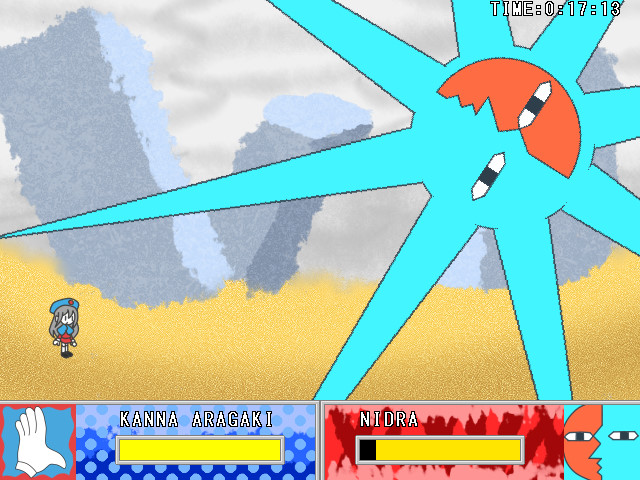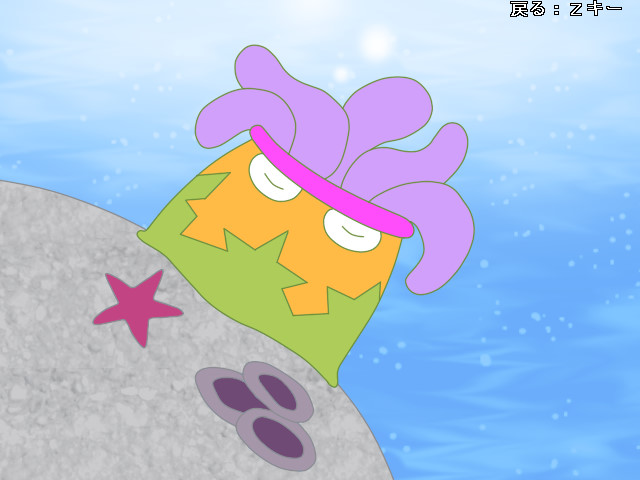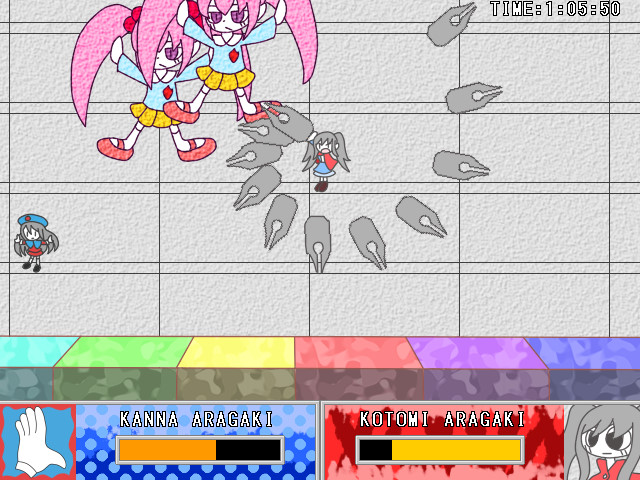Lunatic War is a game consisting entirely of 12 boss fights separated by brief dialogue skits (all in Japanese) and it makes the most of the content it has to offer. Every boss has a unique and often creative design and, more importantly, each fight is memorable with some fights consisting of two or more phases. Though there are not multiple difficulties, you have access to both a Mega Man buster and a Kirby-ish magic glove and your choice between the two dramatically alters how you approach nearly every fight.

The weapon you choose at the start completely changes the flow of fights. Between the Buster Gun and the Mugic [sic] Hand, the gun is the more active and beginner-friendly of the two. With the gun, you can shoot a small blast of energy with every press of the button to chip away at a boss’s health or you can charge up a larger, more powerful shot. However, taking damage will knock you out of your charge and shots can still collide with a boss’s own projectiles. The best time to attack most bosses when using the gun is usually during their own attacks because the downtime between attacks serves as a safe opportunity to charge up. The one catch here is bosses who spend a lot of time far above the ground can be difficult to deal large amounts of damage to as you must constantly keep them in your line of sight while jumping, but overall most bosses are easy enough to defeat by chipping away at their health with a relentless string of attacks.

Contrasting to the Buster Gun, the Magic Hand is a slow, hard-hitting weapon which relies upon using a boss’s own attacks against it. This magical glove has a relatively short range and cannot directly cause damage, but what it can do is grab projectiles or stars, which are briefly created after most attacks at the point of impact like in Kirby, and toss them back at a boss. Like the gun’s energy bullets, these counterattacks can collide with solid projectiles launched by bosses so you need to take careful aim in order to not waste a shot, especially since you can only hold on to one object at a time, but the damage a boss takes from a single hit with the Magic Hand is significantly higher than that of the Buster Gun’s charge shots. Figuring out attack patterns is essential with this weapon due to your own attacks relying so heavily upon getting close to the attacks launched by the bosses in order to grab stars before they disappear. The flow of combat with this weapon is also opposite to that of combat with the gun as you need to use the time during which a boss is attacking to play defensively in order to grab something with the glove and then make use of the windows between attacks to go on the offensive. More aerial-oriented bosses are much easier to fight with the glove as well due to only needing to line up a single attack at a time. Between the two, the Magic Glove is a bit harder to use, but I like it more as the inability to constantly stay on the offensive adds a greater sense of dynamic flow to the battles.

The fights themselves are on the easy side of things and only a few bosses near the end put up a serious fight, but the generally low difficulty doesn’t prevent these fights from being entertaining. In addition using your weapon of choice, the protagonist, Kanna Aragaki, is able to jump through the air indefinitely and she can also duck and slide, though I never found much of a reason to bother ducking or sliding and I didn’t even realize they existed during my first playthrough. Each boss has a distinctive style of fighting as some mostly stay on the ground, some fly or warp through the air, and some prefer to launch attacks while remaining safely in the background. Bosses also aren’t always one-on-one affairs as certain fights involve taking on multiple bosses at once or with two bosses confronting you one after the other without allowing for a health refill. The skits between fights are in Japanese so you’re out of luck on the story side of things if you can’t read the language, though tossing the manual into a translator indicates that the overall plot involves mysterious invaders attacking the planet and the protagonist hunting them down for the sake of collecting bounty money. Judging by the tone of the basic plot, there are probably a few amusing jokes within this dialogue exchanges, but on the plus side you still get to see a well-done drawing of each boss after it is defeated.

The most impressive aspect of these boss fights is just how well-paced they tend to be. Regardless of the weapon you choose, playing well usually results in the boss dying right around the time it reaches the end of its attack pattern. Fights also never feel like they drag on too long as most can be completed within a single minute and even multi-phase fights rarely go beyond the two minute mark. Though there isn’t a direct scoring system in place, Lunatic War does keep track of your best time on each fight with each weapon and you can instantly refight any boss from the main menu if you want to improve your times. The only complaint I have here is that I do wish the overall pacing was as solid as the pacing is within individual fights. While I have no issues with the game being easy, the difficulty does come across as being a bit too flat other than during the final two fights; a refight in the second half of the game against a ‘tougher’ version of the first boss is only slightly harder than the initial fight and the other bosses, while mechanically varied, all hover around this same general level of difficulty.
This is a game which could definitely benefit from multiple difficulty settings or a more even difficulty curve. Nevertheless, Lunatic War presents an entertaining, colorful, creative, and highly recommended boss rush experience.